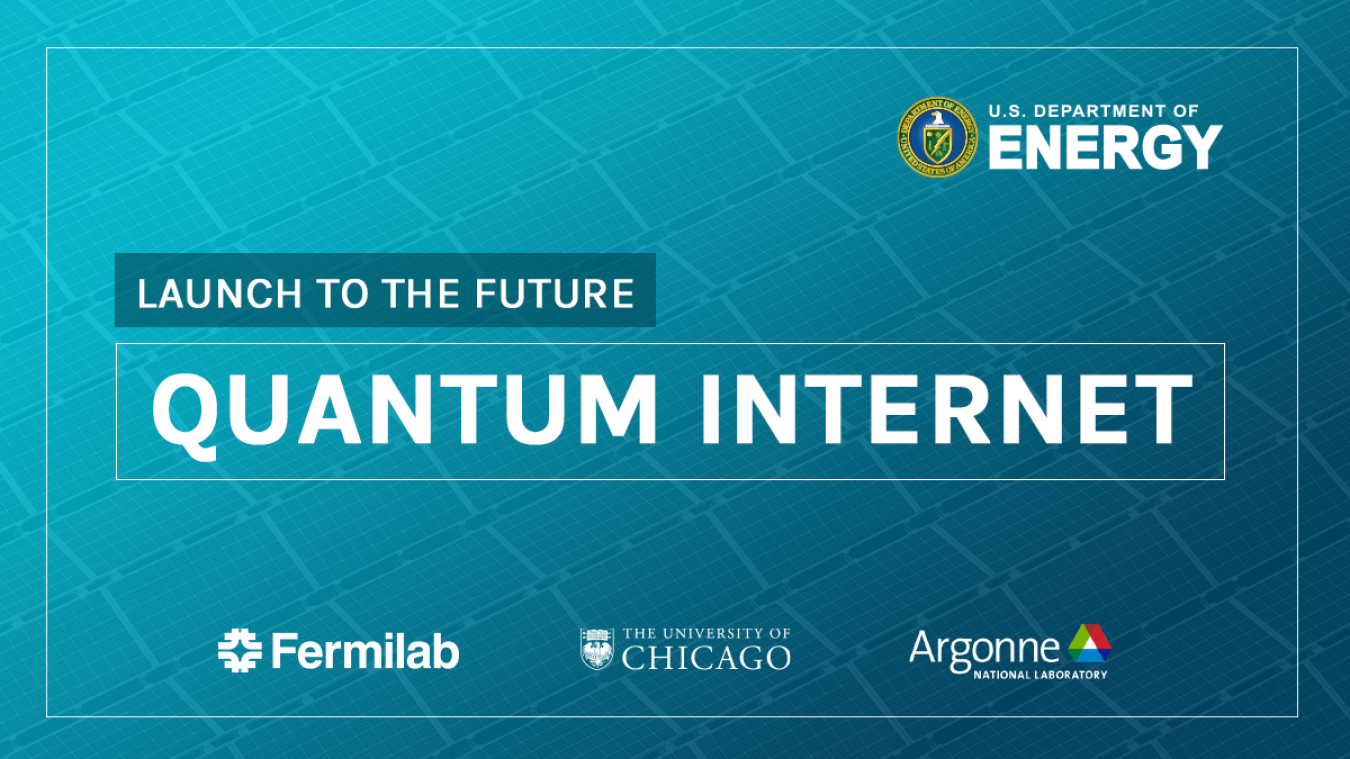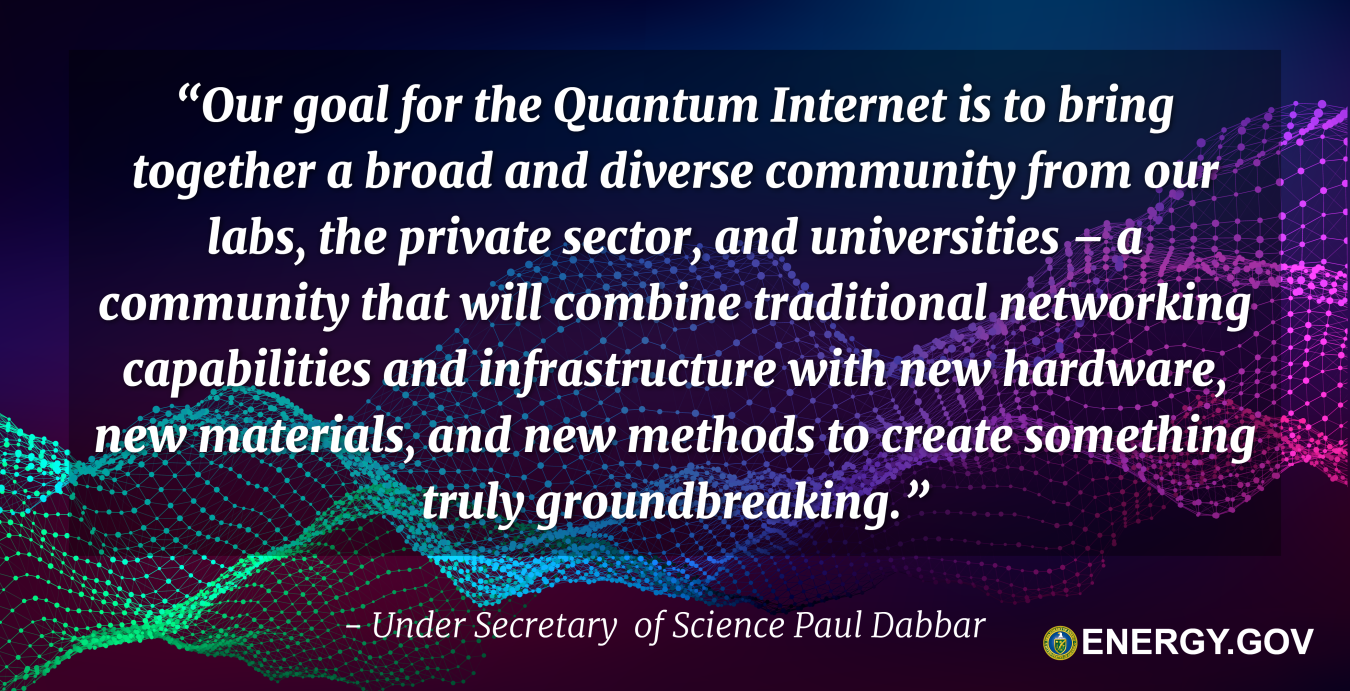The Department of Energy announced America’s Blueprint for the Quantum Internet.
July 23, 2020
By Paul Dabbar, Under Secretary for Science
Today, the Department of Energy (DOE) announced America’s Blueprint for the Quantum Internet. When developed with DOE’s National Labs and private sector partners, the Quantum Internet will offer a world of new possibilities and opportunities.
In February, I wrote in The Hill that under President Donald Trump’s leadership and spearheaded by DOE’s national labs, we are one step closer to a completely secure internet. The Quantum Internet will one day connect computers that can solve challenges of incredible complexity, enabling a faster flow of information and opening up entirely new areas of scientific research and economic development.

We now have the Blueprint to make this Quantum Internet a reality, and I am elated to share our plan with you all today.
The Blueprint lays out four priority research opportunities to make this happen:
- Providing the foundational building blocks for Quantum Internet;
- Integrating Quantum networking devices;
- Creating repeating, switching, and routing technologies for Quantum entanglement;
- Enabling error correction of Quantum networking functions.
As part of DOE’s effort, Argonne and Fermi National Labs will continue to play a critical part in our effort to develop this Quantum Internet and realize its many benefits.
These experts are already making extraordinary achievements. For example, in February, the Chicago Quantum Exchange – anchored by the University of Chicago and Argonne and Fermilab – launched a 52-mile testbed for Quantum communications amongst several other universities, which will allow scientists and engineers to address the challenges of operating a Quantum network under real-world conditions.
Of course, the research benefits from “Quantum sensors” will also be transformative for our entire way of life. Quantum sensor networks could be equally transformative, with applications ranging from increasing our understanding of dark matter to improving the resolution of extra-solar planets to making better predictions of volcanic eruptions.
Eventually, we will connect all 17 DOE National Labs as the backbone of the Quantum Internet. We’ll also add in universities and private sector partners, working with a broad community of individuals and institutions with diverse and complementary skill sets. Together, we’ll create something truly groundbreaking that will transform our lives.

This effort will require the cooperation of all Americans, and the Trump Administration is fostering an environment of bipartisanship in our Quantum Internet mission. The National Quantum Initiative Act, signed into law by President Trump in December 2018, commits the United States to maintaining and expanding its leadership in Quantum information science (QIS), as well as developing new Quantum capabilities.
Ultimately, America’s private sector will unleash the full potential of the Quantum Internet. Just as the American people did with today’s internet, through private sector investment and innovation came an entirely new economy. The Quantum Internet presents a next-generation public square for discussions and, once made widely available, can metamorphosize our entire way of life.
Human beings were born to create. The Quantum Internet will allow Americans to take their imagination and vision to unprecedented levels of creation that will expand human freedom, advance our national security, and increase economic prosperity. We could not be more excited to see what’s in store for the American people via the Quantum Internet.

Paul M. Dabbar

The Honorable Paul M. Dabbar served as the Department’s fourth Under Secretary for Science, He served as the Department’s principal advisor on fundamental energy research, energy technologies, and science, driving this mission through programs including nuclear and high energy particle physics, basic energy, advanced computing, fusion, and biological and environmental research, and direct management over a majority of the Department’s national labs and their world-leading user facilities. In addition, Mr. Dabbar managed the environmental and legacy management missions of the Department, addressing the U.S. legacy of nuclear weapons production and government-sponsored nuclear energy research. In addition, Mr. Dabbar is the lead for technology commercialization activities for the Department and its 17 national labs.
During his time in government service, Mr. Dabbar has traveled to both the North and South Poles. He traveled to the North Pole by submarine to conduct environmental research while in the Navy, and to the South Pole in support of high energy physics astronomy missions by the Department at South Pole Station.
Prior to confirmation as Under Secretary for Science, Mr. Dabbar worked in operations, finance, and strategy roles in the energy sector. As a Managing Director at J.P. Morgan, leading various energy business areas, he has over $400 billion in investment experience across all energy sectors including solar, wind, geothermal, distributed-generation, utility, LNG, pipeline, oil & gas, trading, and energy technologies, and has also led the majority of all nuclear transactions. In addition, he had a senior leadership role for the company’s commodity trading business, including power, oil and gas.
Before joining J.P. Morgan, Mr. Dabbar served as a nuclear submarine officer in Mare Island, California, and Pearl Harbor, Hawaii. He also served on the Department of Energy Environmental Management Advisory Board. He has been a lecturer at the U.S. Naval Academy, and conducted research at the Johns Hopkins University Applied Physics Laboratory. He is also a member of the Council on Foreign Relations.
Mr. Dabbar received a B.S. degree from the U.S. Naval Academy, and a masters degree from Columbia University. Mr. Dabbar and his wife, Andrea, are the parents of two children.

